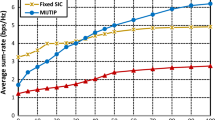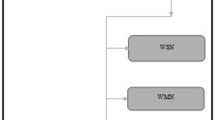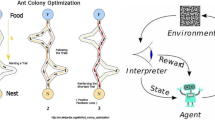Abstract
There has been a rapid increase in usage of unmanned aerial vehicles (UAVs) in different application areas that are unfriendly to humans. These UAVs have been used in Aerial Mesh Networks (AMNs) that act as backbone network to support communication in a post-disaster scenario. However, there may be limited available number of UAV nodes that need to be utilized efficiently to improve the performance of such networks. Here, we consider three important objectives of the network i.e. target coverage, Quality of Service and energy consumption by the network that need to be optimized efficiently to improve the performance. Yet, it is a grueling task to optimize all of these conflicting objectives at the same time, which is affected by the height of UAVs. To optimize more than one conflicting objectives, we used metaheuristic based multi-objective optimization algorithms i.e. Multi-objective Particle Swarm Optimization (MOPSO), Non-dominated Sorting Genetic Algorithm II (NSGA-II), Strength Pareto Evolutionary Algorithm 2 (SPEA2) and Pareto Envelope-based Selection Algorithm II (PESA-II), which suggest the optimal placement of UAVs. These algorithms are compared based on four performance metrics i.e. generational distance, diversification metric, spread of non-dominant solutions and percentage of domination in three different scenarios. The rigorous experiments are performed by each algorithm in small, medium and large-scale scenarios to compare their results. The ANOVA’s validation test suggests that SPEA2 performs better than others in small-scale scenarios while NSGA-II performs better than others in medium and large-scale scenarios. However, MOPSO has lowest average execution time, after that NSGA-II, then PESA-II and then SPEA2.









Similar content being viewed by others
Notes
References
Alzenad M, El-Keyi A, Lagum F, Yanikomeroglu H (2017) 3-D placement of an unmanned aerial vehicle base station (UAV-BS) for energyefficient maximal coverage. IEEE Wirel Commun Lett 6(4):434–437
Alzenad M, El-Keyi A, Yanikomeroglu H (2017) 3-D placement of an unmanned aerial vehicle base station for maximum coverage of users with different QoS requirements. IEEE Wirel Commun Lett 7(1):38–41
Arzamendia M, Espartza I, Reina D, Toral S, Gregor D (2019) Comparison of Eulerian and Hamiltonian circuits for evolutionarybased path planning of an autonomous surface vehicle for monitoring Ypacarai Lake. J Ambient Intell Humaniz Comput 10(4):1495–1507
Bentz W, Hoang T, Bayasgalan E, Panagou D (2018) Complete 3-D dynamic coverage in energy-constrained multi-UAV sensor networks. Auton Robots 42(4):825–851
Caillouet C, Razafindralambo T (2017) Efficient deployment of connected unmanned aerial vehicles for optimal target coverage. In 2017 Global Information Infrastructure and Networking Symposium (GIIS) (pp. 1-8)
Carletti V, Greco A, Saggese A, Vento M (2019) An intelligent flying system for automatic detection of faults in photovoltaic plants. J Ambient Intell Humaniz Comput 11(5):2027–2040
Chouhan VK, Khan SH, Hajiaghaei-Keshteli M, et al. (2020) Multifacility- based improved closed-loop supply chain network for handling uncertain demands. Soft Comput 24(10):7125–7147
Coello CC, Lechuga MS (2002) MOPSO: A proposal for multiple objective particle swarm optimization. In: Proceedings of the 2002 Congress on Evolutionary Computation. CEC’02 (Cat. No. 02TH8600) (Vol. 2, pp. 1051- 1056)
Coello CC, Lechuga DW, Jerram NR, Knowles JD, Oates MJ (2001) PESAII: Region-based selection in evolutionary multiobjective optimization. In: Proceedings of the 3rd Annual Conference on Genetic and Evolutionary Computation (pp. 283-290)
Deb K, Pratap A, Agarwal S, Meyarivan T (2002) A fast and elitist multiobjective genetic algorithm: NSGA-II. IEEE Trans Evol Comput 6(2):182–197
Di Felice M, Trotta A, Bedogni L, Chowdhury KR, Bononi L (2014) Self-organizing aerial mesh networks for emergency communication. In: 2014 IEEE 25th Annual International Symposium on Personal, Indoor, and Mobile Radio Communication (PIMRC), pp 1631–1636
Gupta L, Jain R, Vaszkun G (2015) Survey of important issues in UAV communication networks. IEEE Commun Surv Tutor 18(2):1123–1152
Harrag N, Refoufi A, Harrag A (2019) New NSGA-II-based OLSR self-organized routing protocol for mobile ad hoc networks. J Ambient Intell Humaniz Comput 10(4):1339–1359
Kar K, Banerjee S (2003) Node placement for connected coverage in sensor networks
Lodeiro-Santiago M, Santos-González I, Caballero-Gil P, Caballero-Gil C (2017) Secure system based on UAV and BLE for improving SAR missions. J Ambient Intell Humaniz Comput. https://doi.org/10.1007/s12652-017-0603-4
Malar ACJ, Kowsigan M, Krishnamoorthy N, Karthick S, Prabhu E, Venkatachalam K (2020) Multi constraints applied energy efficient routing technique based on ant colony optimization used for disaster resilient location detection in mobile ad-hoc network. J Ambient Intell Humaniz Comput. https://doi.org/10.1007/s12652-020-01767-9
Mazzarella JR, Wengrovitz MS (2017, May 16) System and method for dynamic wireless aerial mesh network. Google Patents. (US Patent 9,654,200)
Mozaffari M, Saad W, Bennis M, Debbah M (2016) Efficient deployment of multiple unmanned aerial vehicles for optimal wireless coverage. IEEE Commun Lett 20(8):1647–1650
Mulligan R, Ammari HM (2010) Coverage in wireless sensor networks: a survey. Netw Protoc Algorithms 2(2):27–53
Pugliese LDP, Guerriero F, Zorbas D, Razafindralambo T (2016) Modelling the mobile target covering problem using flying drones. Optim Lett 10(5):1021–1052
Ramirez-Atencia C, Camacho D (2019) Constrained multi-objective optimization for multi-UAV planning. J Ambient Intell Humaniz Comput 10(6):2467–2484
Riquelme N, Von Lücken C, Baran B (2015) Performance metrics in multi-objective optimization. In: 2015 Latin American Computing Conference (CLEI), pp 1–11
Rodríguez-Canosa GR, Thomas S, Del Cerro J, Barrientos A, MacDonald B (2012) A real-time method to detect and track moving objects (DATMO) from unmanned aerial vehicles (UAVs) using a single camera. Remote Sens 4(4):1090–1111
Sabino S, Grilo A (2018) Topology control of unmanned aerial vehicle (uav) mesh networks: A multi-objective evolutionary algorithm approach. In: Proceedings of the 4th ACM Workshop on Micro Aerial Vehicle Networks, Systems, and Applications, pp 45–50
Saeed A, Abdelkader A, Khan M, Neishaboori A, Harras KA, Mohamed A (2019) On realistic target coverage by autonomous drones. ACM Trans Sensor Netw (TOSN) 15(3):1–33
Schleich J, Panchapakesan A, Danoy G, Bouvry P (2013) UAV fleet area coverage with network connectivity constraint. In: Proceedings of the 11th ACM international symposium on Mobility management and wireless access (pp. 131-138)
Sombolestan S, Rasooli A, Khodaygan S (2019) Optimal path-planning for mobile robots to find a hidden target in an unknown environment based on machine learning. J Ambient Intell Humaniz Comput 10(5):1841–1850
Stoline MR (1981) The status of multiple comparisons: simultaneous estimation of all pairwise comparisons in one-way ANOVA designs. Am Stat 35(3):134–141
Thai MT, Wang F, Du DH, Jia X (2008) Coverage problems in wireless sensor networks: designs and analysis. Int J Sens Netw 3(3):191
Tuba E, Capor-Hrosik R, Alihodzic A, Tuba M (2017) Drone placement for optimal coverage by brain storm optimization algorithm. In: International Conference on Health Information Science, pp. 167–176
Wang Q, Hempstead M, Yang W (2006) A realistic power consumption model for wireless sensor network devices. In: 2006 3rd annual IEEE communications society on sensor and ad hoc communications and networks, Vol. 1, pp 286–295
Yang Q, Yoo S-J (2018) Optimal UAV path planning: sensing data acquisition over IoT sensor networks using multi-objective bio-inspired algorithms. IEEE Access 6:13671–13684
Yanmaz E (2012) Connectivity versus area coverage in unmanned aerial vehicle networks. In: 2012 IEEE International Conference on Communications (ICC), pp 719–723
Younis M, Akkaya K (2008) Strategies and techniques for node placement in wireless sensor networks: a survey. Ad Hoc Netw 6(4):621–655
Zhou L, Yang Z, Zhou S, Zhang W (2018) Coverage probability analysis of UAV cellular networks in urban environments. In: 2018 IEEE International Conference on CommunicationsWorkshops (ICCWorkshops), pp 1–6)
Zitzler E, Laumanns M, Thiele L (2001) SPEA2: Improving the strength Pareto evolutionary algorithm. TIK-report, 103
Zorbas D, Pugliese LDP, Razafindralambo T, Guerriero F (2016) Optimal drone placement and cost-efficient target coverage. J Netw Computr Appl 75:16–31
Author information
Authors and Affiliations
Corresponding author
Additional information
Publisher's Note
Springer Nature remains neutral with regard to jurisdictional claims in published maps and institutional affiliations.
Rights and permissions
About this article
Cite this article
Gupta, M., Varma, S. Optimal placement of UAVs of an aerial mesh network in an emergency situation. J Ambient Intell Human Comput 12, 343–358 (2021). https://doi.org/10.1007/s12652-020-01976-2
Received:
Accepted:
Published:
Issue Date:
DOI: https://doi.org/10.1007/s12652-020-01976-2




